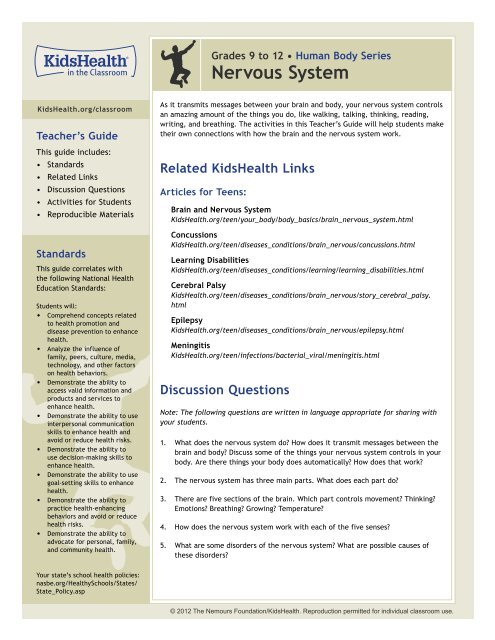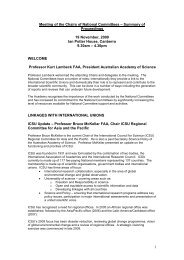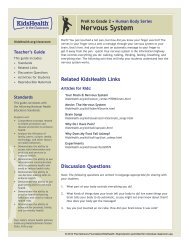Teacher's Guide: Nervous System (Grades 9 to 12) - KidsHealth
Teacher's Guide: Nervous System (Grades 9 to 12) - KidsHealth
Teacher's Guide: Nervous System (Grades 9 to 12) - KidsHealth
You also want an ePaper? Increase the reach of your titles
YUMPU automatically turns print PDFs into web optimized ePapers that Google loves.
<strong>Grades</strong> 9 <strong>to</strong> 12 • Human Body Series<strong>Nervous</strong> <strong>System</strong>Activities for StudentsNote: The following activities are written in language appropriate for sharing with your students.<strong>Nervous</strong> Nellie’s Study GameObjectives:Students will:• Identify the parts and functions of the nervous system• Create and play a game <strong>to</strong> reinforce learning about the nervous systemMaterials:• Computer with Internet access, <strong>KidsHealth</strong> “Brain and <strong>Nervous</strong> <strong>System</strong>” article• “<strong>Nervous</strong> Nellie’s Study Game” handout• Index cards, scissors, penClass Time:• 1 hourActivity:<strong>Nervous</strong> Nellie has an upcoming quiz on the brain and nervous system. To prepare for the test, she created a game<strong>to</strong> help her study (which is really just strengthening her neural memory connections, right?). You can do the same.Follow the directions on the “<strong>Nervous</strong> Nellie’s Study Game” handout <strong>to</strong> make and play the game and give your brain aworkout <strong>to</strong> get in shape for your quiz.Extension:Visit <strong>KidsHealth</strong>.com and research a brain or neurological disorder. Share this information with your classmates in a2-minute presentation. Be sure <strong>to</strong> include the effects on the body and the cause, if known.© 2012 The Nemours Foundation/<strong>KidsHealth</strong>. Reproduction permitted for individual classroom use.
<strong>Grades</strong> 9 <strong>to</strong> 12 • Human Body Series<strong>Nervous</strong> <strong>System</strong><strong>Nervous</strong> <strong>System</strong> DiagramObjectives:Students will:• Draw diagrams of the brain and nervous system• Identify the parts of the brain and nervous system and their functionsMaterials:• Computer with Internet access, <strong>KidsHealth</strong> “Brain and <strong>Nervous</strong> <strong>System</strong>” article• Paper or poster board• Markers, colored pencilsClass Time:• 1 hourActivity:After reading the <strong>KidsHealth</strong> articles related <strong>to</strong> the nervous system, draw a diagram of the brain and nervous system.Clearly label the parts and briefly cite their functions. Use the <strong>KidsHealth</strong> interactive diagram of the brain, in the“Brain and <strong>Nervous</strong> <strong>System</strong>” article, as a guide for your drawing of the brain.Extension:Discuss how other body systems, like the respira<strong>to</strong>ry or circula<strong>to</strong>ry systems, work <strong>to</strong>gether with the nervous system.Brains<strong>to</strong>rm other bodily functions and activities that involve multiple body systems and name the systems. Doublecheckthe facts at <strong>KidsHealth</strong>.org.Reproducible MaterialsHandout: <strong>Nervous</strong> Nellie’s Study Game<strong>KidsHealth</strong>.org/classroom/9<strong>to</strong>12/body/systems/nervous_system_handout1.pdfQuiz: <strong>Nervous</strong> <strong>System</strong><strong>KidsHealth</strong>.org/classroom/9<strong>to</strong>12/body/systems/nervous_system_quiz.pdfQuiz Answers: <strong>Nervous</strong> <strong>System</strong><strong>KidsHealth</strong>.org/classroom/9<strong>to</strong>12/body/systems/nervous_system_quiz_answers.pdf<strong>KidsHealth</strong>.org is devoted <strong>to</strong> providing the latest children’s health information. The site, which is widelyrecommended by educa<strong>to</strong>rs, libraries, and school associations, has received the “Teachers’ Choice Awardfor the Family” and the prestigious Pirelli Award for “Best Educational Media for Students.” <strong>KidsHealth</strong> comesfrom the nonprofit Nemours Foundation. Check out www.<strong>KidsHealth</strong>.org <strong>to</strong> see the latest additions!© 2012 The Nemours Foundation/<strong>KidsHealth</strong>. Reproduction permitted for individual classroom use.
Personal Health Series<strong>Nervous</strong> <strong>System</strong>Name:Date:<strong>Nervous</strong> Nellie’s Study GameDirections: Fold 22 index cards in half lengthwise. Write the vocabulary words in the list below on the <strong>to</strong>p half of the cards, andbrief definitions on the bot<strong>to</strong>m half. (You can find the definitions in the <strong>KidsHealth</strong> “Brain and <strong>Nervous</strong> <strong>System</strong>” article.) Cut thecards in half, put a dot on the back of the word cards, and place the cards face down and spread out. Turn one dot card and oneplain card over for each turn <strong>to</strong> try <strong>to</strong> match a word with a definition. Turn both face down when they don’t match, and both faceup when they do match. Repeat until all are face up.Au<strong>to</strong>nomic nervous systemBrainBrain stemCerebellumCerebral palsyCerebrospinal fluidCorpus collosumCortexEpilepsyHemispheresHippocampusHypothalamusMeningesMeningitis<strong>Nervous</strong> systemNeuronsParasympathetic nervous systemPeripheral nervous systemPituitary glandSpinal cordSympathetic nervous systemThalamusBraincentral computer thatcontrols all the functionsof your body© 2012 The Nemours Foundation/<strong>KidsHealth</strong>. Reproduction permitted for individual classroom use.
Personal Health Series<strong>Nervous</strong> <strong>System</strong>Name:Date:QuizInstructions: Answer each question.1. Your is the boss of your body and controls everything you do.2. The nervous system is made up of the brain, spinal cord, and .3. The spinal cord helps carry back and forth between your body and brain.4. How many nerves are in your body <strong>to</strong> send messages <strong>to</strong> brain and back?a. dozensb. hundredsc. thousandsd. millionse. billions5. What kinds of things are your brain and nervous system in charge of?a. walking and runningb. thinking and talkingc. feeling and sleepingd. breathing and growinge. all of the above6. How much does the average brain weigh?7. A nerve cell is also called a .8. Name the five main parts of the brain and one function of each:9. The peripheral nervous system:a. is in the brainb. includes nerves branching out from the spinal cord <strong>to</strong> the bodyc. helps with peripheral vision10. Breathing, digestion, sweating, and shivering are all functions of the nervous system.11. Both the brain and spinal cord are protected by .12. Neurons relay information <strong>to</strong> each other through a complex process.13. Name one function of cerebrospinal fluid:© 2012 The Nemours Foundation/<strong>KidsHealth</strong>. Reproduction permitted for individual classroom use.
Personal Health Series<strong>Nervous</strong> <strong>System</strong>Quiz Answer Key1. Your brain is the boss of your body and controls everything you do.2. The nervous system is made up of the brain, spinal cord, and nerves .3. The spinal cord helps carry messages or signals back and forth between your body and brain.4. How many nerves are in your body <strong>to</strong> send messages <strong>to</strong> brain and back?a. dozensb. hundredsc. thousandsd. millionse. billions5. What kinds of things are your brain and nervous system in charge of?a. walking and runningb. thinking and talkingc. feeling and sleepingd. breathing and growinge. all of the above6. How much does the average brain weigh?About 3 pounds.7. A nerve cell is also called a neuron .8. Name the five main parts of the brain and one function of each:cerebrum, thinking or movingcerebellum, balance or coordinationbrain stem, breathing or circulation or digestionhypothalamus, body temperature or appetite or sleeppituitary gland, growth or metabolism9. The peripheral nervous system:a. is in the brainb. includes nerves branching out from the spinal cord <strong>to</strong> the bodyc. helps with peripheral vision10. Breathing, digestion, sweating, and shivering are all functions of the au<strong>to</strong>nomic nervous system.11. Both the brain and spinal cord are protected by bone .12. Neurons relay information <strong>to</strong> each other through a complex electrochemical process.13. Name one function of cerebrospinal fluid:(any one of the following: helps protect nerve tissue, keeps nerve tissue healthy, helps removes waste products from brainand spinal cord)© 2012 The Nemours Foundation/<strong>KidsHealth</strong>. Reproduction permitted for individual classroom use.
















